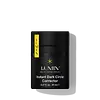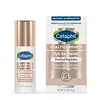What's inside
What's inside
 Key Ingredients
Key Ingredients

 Benefits
Benefits

 Concerns
Concerns

 Ingredients Side-by-side
Ingredients Side-by-side

Water
Skin ConditioningGlycerin
HumectantCetearyl Alcohol
EmollientPolyglycerin-3
Humectant1,2-Hexanediol
Skin ConditioningNiacinamide
SmoothingMethylpropanediol
SolventButyrospermum Parkii Butter
Skin ConditioningSimmondsia Chinensis Seed Oil
EmollientIsododecane
EmollientButylene Glycol
HumectantPropanediol
SolventCamellia Sinensis Leaf Extract
AntimicrobialZingiber Officinale Root Extract
MaskingGlycyrrhiza Glabra Root Extract
BleachingSchisandra Chinensis Fruit Extract
Skin ConditioningCaffeine
Skin ConditioningCoptis Chinensis Root Extract
AntioxidantTocopheryl Acetate
AntioxidantC14-22 Alcohols
Emulsion StabilisingSodium Hyaluronate
HumectantPolyacrylate-13
Sodium Polyacrylate Starch
AbsorbentCarbomer
Emulsion StabilisingTromethamine
BufferingPolyisobutene
C12-20 Alkyl Glucoside
EmulsifyingPolyglyceryl-10 Myristate
Skin ConditioningAcmella Oleracea Extract
Skin ProtectingPotassium Cetyl Phosphate
EmulsifyingCaprylyl Glycol
EmollientPolysorbate 20
EmulsifyingPropolis Wax
EmollientDisodium EDTA
Sorbitan Isostearate
EmulsifyingAluminum Hydroxide
EmollientTriethoxycaprylylsilane
Parfum
MaskingCoffea Arabica Seed Extract
MaskingCocos Nucifera Oil
MaskingGlyceryl Undecylenate
EmollientCoco-Caprylate
EmollientGlucose
HumectantCI 77891
Cosmetic ColorantCI 19140
Cosmetic ColorantCI 16035
Cosmetic ColorantWater, Glycerin, Cetearyl Alcohol, Polyglycerin-3, 1,2-Hexanediol, Niacinamide, Methylpropanediol, Butyrospermum Parkii Butter, Simmondsia Chinensis Seed Oil, Isododecane, Butylene Glycol, Propanediol, Camellia Sinensis Leaf Extract, Zingiber Officinale Root Extract, Glycyrrhiza Glabra Root Extract, Schisandra Chinensis Fruit Extract, Caffeine, Coptis Chinensis Root Extract, Tocopheryl Acetate, C14-22 Alcohols, Sodium Hyaluronate, Polyacrylate-13, Sodium Polyacrylate Starch, Carbomer, Tromethamine, Polyisobutene, C12-20 Alkyl Glucoside, Polyglyceryl-10 Myristate, Acmella Oleracea Extract, Potassium Cetyl Phosphate, Caprylyl Glycol, Polysorbate 20, Propolis Wax, Disodium EDTA, Sorbitan Isostearate, Aluminum Hydroxide, Triethoxycaprylylsilane, Parfum, Coffea Arabica Seed Extract, Cocos Nucifera Oil, Glyceryl Undecylenate, Coco-Caprylate, Glucose, CI 77891, CI 19140, CI 16035
Water
Skin ConditioningGlycerin
HumectantPropanediol
SolventPanthenol
Skin Conditioning1,2-Hexanediol
Skin ConditioningNiacinamide
SmoothingC13-15 Alkane
SolventButyrospermum Parkii Butter
Skin ConditioningCocos Nucifera Oil
MaskingSodium Polyacryloyldimethyl Taurate
Emulsion StabilisingHydrogenated Polydecene
EmollientSilica
AbrasiveTocopheryl Acetate
AntioxidantVinyldimethicone
C14-22 Alcohols
Emulsion StabilisingLeontopodium Alpinum Extract
Skin ConditioningPolyglyceryl-2 Stearate
EmulsifyingPolyacrylate-13
C12-20 Alkyl Glucoside
EmulsifyingOryza Sativa Lees Extract
Skin ConditioningGlyceryl Stearate
EmollientStearyl Alcohol
EmollientPolyisobutene
Hydrolyzed Soy Flour
Skin ConditioningAdenosine
Skin ConditioningDimethicone/Vinyl Dimethicone Crosspolymer
Skin ConditioningButylene Glycol
HumectantTrisodium Ethylenediamine Disuccinate
Acacia Senegal Gum
MaskingCitric Acid
BufferingAgar
MaskingCaprylyl Glycol
EmollientPolysorbate 20
EmulsifyingSodium Benzoate
MaskingSorbitan Isostearate
EmulsifyingPotassium Sorbate
PreservativeSodium Hyaluronate
HumectantXanthan Gum
EmulsifyingEthylhexylglycerin
Skin ConditioningBuddleja Davidii Extract
Skin ConditioningThymus Vulgaris Extract
PerfumingWater, Glycerin, Propanediol, Panthenol, 1,2-Hexanediol, Niacinamide, C13-15 Alkane, Butyrospermum Parkii Butter, Cocos Nucifera Oil, Sodium Polyacryloyldimethyl Taurate, Hydrogenated Polydecene, Silica, Tocopheryl Acetate, Vinyldimethicone, C14-22 Alcohols, Leontopodium Alpinum Extract, Polyglyceryl-2 Stearate, Polyacrylate-13, C12-20 Alkyl Glucoside, Oryza Sativa Lees Extract, Glyceryl Stearate, Stearyl Alcohol, Polyisobutene, Hydrolyzed Soy Flour, Adenosine, Dimethicone/Vinyl Dimethicone Crosspolymer, Butylene Glycol, Trisodium Ethylenediamine Disuccinate, Acacia Senegal Gum, Citric Acid, Agar, Caprylyl Glycol, Polysorbate 20, Sodium Benzoate, Sorbitan Isostearate, Potassium Sorbate, Sodium Hyaluronate, Xanthan Gum, Ethylhexylglycerin, Buddleja Davidii Extract, Thymus Vulgaris Extract
Ingredients Explained
These ingredients are found in both products.
Ingredients higher up in an ingredient list are typically present in a larger amount.
1,2-Hexanediol is a synthetic liquid and another multi-functional powerhouse.
It is a:
- Humectant, drawing moisture into the skin
- Emollient, helping to soften skin
- Solvent, dispersing and stabilizing formulas
- Preservative booster, enhancing the antimicrobial activity of other preservatives
Butylene Glycol (or BG) is used within cosmetic products for a few different reasons:
Overall, Butylene Glycol is a safe and well-rounded ingredient that works well with other ingredients.
Though this ingredient works well with most skin types, some people with sensitive skin may experience a reaction such as allergic rashes, closed comedones, or itchiness.
Learn more about Butylene GlycolThis ingredient is also known as shea butter. It is an effective skin hydrator and emollient.
Emollients help soothe and soften your skin. It does this by creating a protective film on your skin. This barrier helps trap moisture and keeps your skin hydrated. Emollients may be effective at treating dry or itchy skin.
Shea butter is rich in antioxidants. Antioxidants help fight free-radicals, or molecules that may harm the body. It is also full of fatty acids including stearic acid and linoleic acid. These acids help replenish the skin and keep skin moisturized.
While Shea Butter has an SPF rating of about 3-4, it is not a sunscreen replacement.
Shea butter may not be fungal acne safe. We recommend speaking with a professional if you have any concerns.
Learn more about Butyrospermum Parkii ButterWe don't have a description for C12-20 Alkyl Glucoside yet.
C14-22 Alcohols is made up of synthetic fatty alcohols. More specifically, these fatty alcohols contain 14 to 22 carbons in the alkyl chain.
Its main purpose is to stabilize products. As an emulsifier, it helps prevent waters and oils from separating.
Caprylyl Glycol is a humectant and emollient, meaning it attracts and preserves moisture.
It is a common ingredient in many products, especially those designed to hydrate skin. The primary benefits are retaining moisture, skin softening, and promoting a healthy skin barrier.
Though Caprylyl Glycol is an alcohol derived from fatty acids, it is not the kind that can dry out skin.
This ingredient is also used as a preservative to extend the life of products. It has slight antimicrobial properties.
Learn more about Caprylyl GlycolCocos Nucifera Oil is obtained from the kernels of the coconut fruit. In other words, this is coconut oil.
Coconut Oil is rich in fatty acids with lauric acid making up the majority of these. It also contains linoleic acid. Due to this high fatty acid content, coconut oil helps trap moisture and soften skin.
Despite being antibacterial, coconut oil may not be great for acne-prone skin. It is comedogenic and may clog pores. This ingredient may not be safe for malassezia or fungal acne.
Note: Coconut Oil should not replace your sunscreen for UV protection. Studies show it only blocks about 20% of UV.
This oil is non-volatile and has a light scent.
The term 'fragrance' is not regulated in many countries. In many cases, it is up to the brand to define this term. For instance, many brands choose to label themselves as "fragrance-free" because they are not using synthetic fragrances. However, their products may still contain ingredients such as essential oils that are considered a fragrance.
Learn more about Cocos Nucifera OilGlycerin is already naturally found in your skin. It helps moisturize and protect your skin.
A study from 2016 found glycerin to be more effective as a humectant than AHAs and hyaluronic acid.
As a humectant, it helps the skin stay hydrated by pulling moisture to your skin. The low molecular weight of glycerin allows it to pull moisture into the deeper layers of your skin.
Hydrated skin improves your skin barrier; Your skin barrier helps protect against irritants and bacteria.
Glycerin has also been found to have antimicrobial and antiviral properties. Due to these properties, glycerin is often used in wound and burn treatments.
In cosmetics, glycerin is usually derived from plants such as soybean or palm. However, it can also be sourced from animals, such as tallow or animal fat.
This ingredient is organic, colorless, odorless, and non-toxic.
Glycerin is the name for this ingredient in American English. British English uses Glycerol/Glycerine.
Learn more about GlycerinNiacinamide is a multitasking form of vitamin B3 that strengthens the skin barrier, reduces pores and dark spots, regulates oil, and improves signs of aging.
And the best part? It's gentle and well-tolerated by most skin types, including sensitive and reactive skin.
You might have heard of "niacin flush", or the reddening of skin that causes itchiness. Niacinamide has not been found to cause this.
In very rare cases, some individuals may not be able to tolerate niacinamide at all or experience an allergic reaction to it.
If you are experiencing flaking, irritation, and dryness with this ingredient, be sure to double check all your products as this ingredient can be found in all categories of skincare.
When incorporating niacinamide into your routine, look out for concentration amounts. Typically, 5% niacinamide provides benefits such as fading dark spots. However, if you have sensitive skin, it is better to begin with a smaller concentration.
When you apply niacinamide to your skin, your body converts it into nicotinamide adenine dinucleotide (NAD). NAD is an essential coenzyme that is already found in your cells as "fuel" and powers countless biological processes.
In your skin, NAD helps repair cell damage, produce new healthy cells, support collagen production, strengthen the skin barrier, and fight environmental stressors (like UV and pollution).
Our natural NAD levels start to decline with age, leading to slower skin repair, visible aging, and a weaker skin barrier. By providing your skin niacinamide, you're recharging your skin's NAD levels. This leads to stronger, healthier, and younger looking skin.
Another name for vitamin B3 is nicotinamide. This vitamin is water-soluble and our bodies don't store it. We obtain Vitamin B3 from either food or skincare. Meat, fish, wheat, yeast, and leafy greens contain vitamin B3.
The type of niacinamide used in skincare is synthetically created.
Learn more about NiacinamidePolyacrylate-13 is a type of acrylate polymer. Acrylate polymers are commonly used as adhesives in cosmetics.
Polyacrylate-13 creates a film to protect the skin. It is also used to thicken and stabilize a product. It works by making water a gel-like consistency. This gel consistency helps suspend particles.
Polyacrylate-13 is a copolymer of acrylic acid, acrylamide, sodium acrylate, sodium acryloyldimethyltaurate monomers
Learn more about Polyacrylate-13Polyisobutene is a synthetic polymer made from isobutene.
It is a film-forming agent and helps bind ingredients together.
Polyisobutene is not absorbed by the skin.
Learn more about PolyisobutenePolysorbate 20 is made by combining ethoxylation of sorbitan, ethylene oxide, and lauric acid. It is a mild cleansing agent, surfactant, and emulsifier.
As a surfactant, it helps collect dirt and oils for washing. Emulsifiers prevent oils and water from separating.
Polysorbate 20 also adds scent to a product. Since it is made using sorbitol, it has a sweet scent. Sorbitol can also be found in fruits such as apples and peaches.
The lauric acid used to create Polysorbate 20 is often derived from coconuts.
Polysorbate 20 may not be fungal acne safe.
Learn more about Polysorbate 20Propanediol is an all-star ingredient. It softens, hydrates, and smooths the skin.
It’s often used to:
Propanediol is not likely to cause sensitivity and considered safe to use. It is derived from corn or petroleum with a clear color and no scent.
Learn more about PropanediolSodium Hyaluronate is hyaluronic acid's salt form. It is commonly derived from the sodium salt of hyaluronic acid.
Like hyaluronic acid, it is great at holding water and acts as a humectant. This makes it a great skin hydrating ingredient.
Sodium Hyaluronate is naturally occurring in our bodies and is mostly found in eye fluid and joints.
These are some other common types of Hyaluronic Acid:
Learn more about Sodium HyaluronateSorbitan Isostearate is an emulsifer and cleaning agent. It is created from isostearic acid and sorbitol.
As an emulsifier, Sorbitan Isostearate prevents oils and water from separating.
Due to its isostearic acid base, it may not be safe for Malassezia or fungal acne.
Learn more about Sorbitan IsostearateTocopheryl Acetate is AKA Vitamin E. It is an antioxidant and protects your skin from free radicals. Free radicals damage the skin by breaking down collagen.
One study found using Tocopheryl Acetate with Vitamin C decreased the number of sunburned cells.
Tocopheryl Acetate is commonly found in both skincare and dietary supplements.
Learn more about Tocopheryl AcetateWater. It's the most common cosmetic ingredient of all. You'll usually see it at the top of ingredient lists, meaning that it makes up the largest part of the product.
So why is it so popular? Water most often acts as a solvent - this means that it helps dissolve other ingredients into the formulation.
You'll also recognize water as that liquid we all need to stay alive. If you see this, drink a glass of water. Stay hydrated!
Learn more about Water